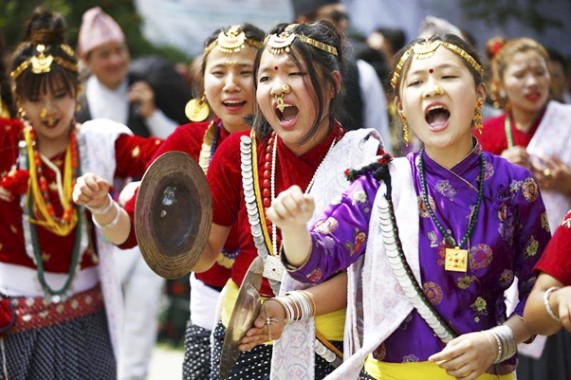




















Saturday, Jul 03, 2021 20:30 [IST]
Last Update: Saturday, Jul 03, 2021 14:48 [IST]
Limboo Community has a rich cultural heritage and one of them is folk songs, which have been transformed orally from generation to generation. Although, a folk song is a traditional song that is typical of a particular community or region. The song is generally based on legendary, historical events, lifestyle and culture. It is an expression of the ways of living developed by a community and inherited from past generations, including customs, places, artistic expression and values.
The Limboos don't have adequate tangible (immovable) cultural heritages, but it has rich oral traditional performing arts, rituals and folk songs. Thus, folk songs are marked generally by simple, melody and narrative verses. Limboo folk songs can be categorised in different forms, like traditional, mundhum, merry-making, and palam (songs), these are all integral components of folk songs. It indicates our history, traditions and enables us to develop an awareness, introspection of why we are the way we are today. It also helps understand that heritage is a keystone of our culture that plays an important role in our politics, economy, society and professions. Limboos have different folk songs for different occasions.
Palam (song) is one popular part of folk songs which is performed during various occasions. Although Palam is an entertaining song, the theme, meaning, and logic is more significant. It carries an in-depth meaning and signifies different occasions. Those songs and dances were most popular till the early 1980s in the western part of Sikkim. The palam is mostly based on mundhum, culture, and ethics but largely it is popular amongst the youths, on the basis of quality composing, feelings, imaginations, thoughts, emotions, expressions, it needs poetic emotions to compose and make an instant reply. The singer needs to be more imaginative and poetic to impress the partner. Thus, the more imaginative and poetic, the better the performance, such qualitative and seasoned singers can go to any extent of time.
Apart from palam there are many other items of Limboo folk songs, these are ; hakparey, tumyanghang, kheeyali, taam-okey, yehang, keylaang, simering and mundhum samlo. Amongst those, hakpare, yehang, tumyanghang-samlo are more common to senior citizens. However, those items are sung during different occasions with different themes and meanings. Senior citizens of limboos (male or female) enjoy and create entertaining (traditional) situations during both marry-making and death rites. The songs which they sing during death rites are different than in marriages or on any festive occasion. The wordings, rhythms, tuning etc are distinct for different occasions. Such a variety of songs seem to be simply entertaining but interestingly, it signifes a meaningful cultural identity of Limboos.
Fortunately, after having recognized the Limboo language as one of the state languages, during the year 1983, the Limboos achieved a new milestone, as AIR (All India Radio) Gangtok introduced the program on 3rd April in the same year. As a matter of fact, the Limboos had to cover up the said program with folk songs, traditional songs, mundhum songs, folk tales, one-act play, essay writings, story writings but all such songs available then were not sufficient. The coverage of the program and to make it more impressive, the AIR requisitioned large numbers of songs by different singers. Thus, the requisition became a herculean task for artists and singers, as we had no modern songs prepared till then. Having seen such situations, amongst all the Limboo music lovers who had little bit of ideas and interest abruptly initiated composing new modern songs, Padmashree B B Muringla then (TBO) who was only the expert with musical background mobilized, gripping all who could help him to sing either way. Whatever may be the situation then the first-ever modern songs articulated by Muringla motivated a huge number of young modern musicians, lyricists and singers which has certainly paved the way for modern music lovers.
Prior to this, the Limboos indeed never thought of having such modern songs.
The first-ever composed modern song by Muringla had heart touching lyrics. It was a self explanatory composition of the situation. "Yakthungsa ga keywaye aattikemoye, mennimendha lokmarey attikegery". meaning thereby "You were born as Limboo but where did you vanish as you moved sightlessly ? ." A sarcastic lyric to Limboos who pretended to be modernized and indicated their passive attitude in the community welfare activities. Thereafter, a series of cascading modern songs were composed by Muringla and followed by the young singers.
Similarly, the first-ever sung traditional group song but slightly modernized was "Kesomba Syasang, aal jyasang" , a group song by B. B. Muringla,Mangal Singh khoyahang, Suk Bdr, Mangmo and late Kamal Maya Khewa. In the initial stages, the singers like justice A.P.Subba, Asha Subba, and Menuka Sawaden had also credibly contributed.
Shri Muringla who was a writer, singer, musician, and lyricist had rich knowledge of music as he had recorded Nepali songs in 1967 from HMV gramophone, Kolkata, the well-known songs were (a) "Kasko jobhan aljhiyecha chapa gurasma" (b) "Aakasaiko badalu urai lagyu batasaile'' with this backdrop Muringla spearheaded the youths / College Students / part-time workers / language teachers and motivated them. The youths, who had musical talent and interest became more and more enthusiastic, the unbridled interest created new vibes in composition of Limboo modern songs. AIR Gangtok demanded more and more modern songs as it needed to be changed daily, replay of songs or repetition was not permitted. Then, dozens of modern songs were required, such a gigantic move of creating new trends in Limboo music wasn't easy, Muringla demonstrated his leadership quality in encouraging youths to compose and sing modern songs. However, with the efforts and leadership of Muringla, a new era emerged for modern songs. The youths generally don't have ideas as to how and when modern songs happened to begin. No matter how the future analysts do contemplate, modernizing the Limboo folk music is a symbolic articulation of Muringla.
During the first initial stages in the year 1987-88, the group of singers like Chandramani, Aitarani, Som Kumari, Sawansingh, Phiphang and G P Tumbapo had actively contributed. Thereafter, the local singers like R L Limbu, Saran Sawaden, Shusila Sawaden, Imahang Setling, Devi Limbu, Sanchaman (darap), and Asha Angbo contributed immensely.
This is the way how limboo songs and music got a new turning point for the first time. It created a new vibration in the young minds who loved music.
Thereafter, the series of modern songs were composed and sung by many more singers from outside the state. Then gradually the singers created interest and jubilant environment spreaded in places like Dajeeling, Kalampong, Doors, Assam and the eastern part of Nepal. As a matter of fact, the singers like Ganga Fhiyak, Sita Singak, Bhagat Limbu, Lila Singak, Sunita Yakthungma, Suman Limbu and Sreyasi Chemzong were seen with improved quality of modern songs. Similarly, Sawan Phurumboo, Ash hang Limboo, Suklall Limboo, Sunita Thegim (nepal) Brabin Sherma (nepal) and Yaden Sherma (nepal) have taken a pertinent position to carry on limboo modern songs in the next peak of modernization. The standard of modern songs have been upgraded and equated to Nepali modern songs, pop, and remix. Beginning from the early 1980s, the Limboo modern songs reaching this stage and gained popularity is an absolutely outstanding achievement. The singers above named, are potentially coming up with different fields of songs like; folk, mundhum, traditional, modern, sentimental, hymns, patriotic, filmy, remix, and pop etc. Its popularity has rapidly spread wherever limboos reside beyond Sikkim, West Bengal, Assam, and Nepal. The vibrations of Limbu Modern songs have reached the UK, USA and Hongkong. All such young artists have contributed immensely for the growth of these modern songs.
The Limboo songs have special characteristics, as they originated from folk music. Because folk music is the music of people, the community, the region, it keeps people connected to their past and their culture. Folk music is the most important in a society and culture, the lyrics and rhythm manifests the people and their lifestyle. The tuning, rhythm and melody of modern songs are more impressive for non-limboos as it is based on folk music. It may be the reason why the limboo modern song as initiated and gaintly spearheaded by Muringla has now gained a remarkable milestone in modernizing the Limboo folk Songs.
(The writer is the former Education Director, Government of Sikkim)
